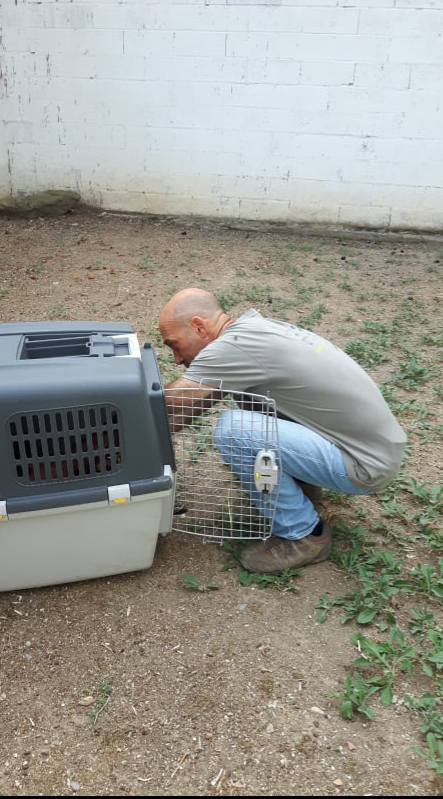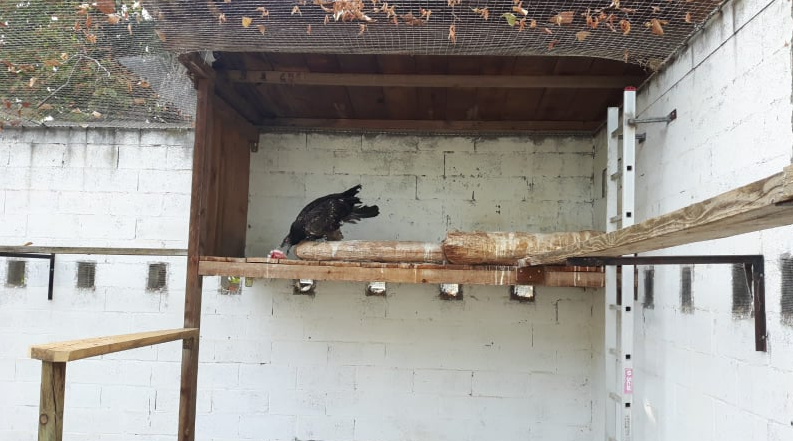
A Bearded Vulture that hatched in Navarra in the Spanish Pyrenees last year had a troublesome start at life. It had to be rescued three times, suffering from different health issues each time. Now, the bird has a new mission in life! The vulture became part of the Bearded Vulture Captive-Breeding Network, coordinated by the Vulture Conservation Foundation (VCF) on behalf of EAZA’s EEP, which breeds the species in captivity to support reintroduction or restocking project.
Rescuing and rehabilitating the Bearded Vulture
The Navarran Bearded Vulture hatched in 2019 but as a chick fell from the nest into a body of water. Thankfully, the fall was not fatal, and he was rescued in time. The vulture entered the recovery centre of Gobierno de Navarre for rehabilitation. It seemed that the fall injured his leg and caused the loss of several tail feathers. Now the feathers, especially the two central feathers from the tail are not growing correctly, in a vertical orientation, which is not suitable for flying. When he grew new feathers, however, they decided to release him later in the autumn of 2019.
After spending two to three weeks in the wild, they found him again in the Spanish Pyrenees, this time suffering from hypothermia. He spent the entire winter in the same recovery centre, and in the beginning of May 2020, they rereleased him. Just a couple of weeks later, on 14 May, they found the bird weak in the French Pyrenees National Park. They easily caught the bird and transferred it to Hegalaldia – Centre de soins pour animaux sauvages in France.
The feathers of the bird were twisted, and since the vulture was released twice and recovered just after a few weeks each time, it indicated that he could not adapt in the natural environment. The reason behind this might be because the learning capacity of the species is just after fledgling, so since the bird spent his first year in captivity, this learning capacity decreased significantly. So, it was decided that he will remain in captivity and become a part of the captive breeding programme.
Future of the bird in the Bearded Vulture EEP
Now, the bird has a new future ahead, contributing to the conservation of its own kind as he became a part of the Bearded Vulture EEP. On 23 September, the VCF’s Captive Vulture Manager and the Bearded Vulture EEP Coordinator drove for hours from Lleida to retrieve the bird from Hegalaldia, and brought the bird to the Specialised Bearded Vulture Breeding Unit at the Recovery Centre Vallcalent on 24 September – his new home! This Centre, managed by the VCF thanks to an agreement with Generalitat de Catalunya, hosts most of the Pyrenean birds within the network.
Importance of captive breeding
The Vulture Conservation Foundation (VCF) is the leading organisation working to protect Europe’s vulture species, with one of its primary goals being the restoration of the Bearded Vulture population back to its former range in Europe. To achieve this goal, the VCF has been sustainably growing its reintroduction programmes across Europe, with projects releasing captive-bred birds from the VCF coordinated Bearded Vulture Captive Breeding Network (EEP) across the Alps, France and Spain. Further to this, the VCF manages two specialised breeding centres in Spain that breed this species for conservation purposes – the Bearded Vulture Captive Breeding Centre of Guadalentín and the Specialised Bearded Vulture Breeding Unit at the Recovery Centre Vallcalent.
We hope this vulture has a long future ahead and manages to breed eventually to support reintroduction or restocking projects!
Sign up to our monthly newsletter to stay tuned with the Bearded Vulture news in Europe.
Photos Credits: VCF
















